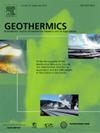Lithium enrichment in high radiogenic geothermal systems originating from lithospheric water due to water-rock interactions
IF 3.9
2区 工程技术
Q3 ENERGY & FUELS
引用次数: 0
Abstract
Hot springs with radiogenic activity and high lithium enrichment has an important role in storing energy extracted from geothermal water. In Bangka Island, Indonesia, there are hot springs that appear in non-volcanic areas with high radiogenic activity and lithium enrichment. However, the origin of radiogenic hot springs in these non-volcanic areas is still not well understood. Geochemical analysis, especially of lithium in geothermal systems, provides important insights into geochemical processes occurring in the Earth's lithosphere. This study explores the mechanism of lithium enrichment in radiogenic hot springs on Bangka Island with a focus on the influence of water-rock interactions. Water samples from six hot springs were analysed for physical parameters, cations, and anions. The results show that the hot springs are classified into three categories; geothermal hot spring water systems with a predominance of sodium-carbonate water (Pemali, Terak, Keretak, and Nyelanding), where lithium enrichment comes from lithospheric water due to the interaction between water and rock, with a high contribution of meteoric water; a geothermal water system with a predominance of sodium chloride water (Dendang) and a geothermal water system with a predominance of sodium chloride water (Permis), where the high lithium enrichment comes from lithospheric water due to the interaction between water and rock, with the influence of seawater. The difference between the calculated and observed magnesium (Mg) concentrations indicates a mixing process prior to heating between meteoric water and seawater. The reservoir temperatures were estimated by quartz geothermometer (63 - 89 °C) as the shallow reservoir mixed with cold meteoric water and multicomponent geothermometer (88 - 111 °C) as the deep reservoir. Our findings reveal that the correlation results between geochemical analysis and geothermometer analysis confirms that Dendang (DND) hot springs originate from older hydrothermal reservoirs with lithospheric water enriched in lithium through water-rock interactions. In contrast, Permis (PMS) hot spring is influenced by shallow aquifers with seawater intrusion, heated by reservoirs at minimal depths, contributing to lithium enrichment. Variations in elevation, proximity to the coast, and geographic factors further shape these systems, with other hot springs in Bangka Island primarily sourced from radiogenically heated shallow groundwater. These findings highlight the potential of radiogenic hot springs in non-volcanic regions as unconventional sources of lithium, contributing to the development of energy storage solutions and advancing geothermal resource utilization.
源自岩石圈水的高放射性成因地热系统中的锂富集与水岩相互作用
具有放射性成因活性和高锂富集的温泉在地热水中具有重要的储能作用。印度尼西亚邦加岛(Bangka Island)的温泉产于非火山区,具有高放射性成因活动和锂富集。然而,在这些非火山地区,放射性成因温泉的成因仍不清楚。地球化学分析,特别是地热系统中的锂,为了解地球岩石圈中发生的地球化学过程提供了重要的见解。本研究探讨了邦加岛放射性成因温泉中锂富集的机理,重点探讨了水岩相互作用的影响。对六个温泉的水样进行了物理参数、阳离子和阴离子的分析。结果表明:温泉可分为三类;以碳酸钠水为主的地热温泉系统(Pemali、Terak、Keretak和Nyelanding),由于水与岩石的相互作用,锂的富集来自岩石圈水,大气水的贡献很大;一个以氯化钠水为主的地热水系统(登当)和一个以氯化钠水为主的地热水系统(珀米斯),在海水的影响下,由于水与岩石的相互作用,岩石圈水对锂的富集程度较高。计算出的镁浓度与观测到的镁浓度之间的差异表明,在加热之前,大气水和海水之间存在混合过程。储层温度由石英地温计(63 ~ 89℃)估算为浅层混合冷降水储层,由多分量地温计(88 ~ 111℃)估算为深层储层。研究结果表明,地球化学分析和地温计分析的对比结果证实了登当(DND)温泉起源于更古老的热液储层,岩石圈水通过水岩相互作用富集锂。相比之下,Permis (PMS)温泉受海水入侵的浅层含水层的影响,由最小深度的水库加热,有助于锂的富集。海拔的变化、靠近海岸和地理因素进一步塑造了这些系统,邦加岛上的其他温泉主要来自放射性加热的浅层地下水。这些发现强调了非火山地区放射性成因温泉作为非常规锂资源的潜力,有助于开发储能解决方案和推进地热资源的利用。
本文章由计算机程序翻译,如有差异,请以英文原文为准。
求助全文
约1分钟内获得全文
求助全文
来源期刊

Geothermics
工程技术-地球科学综合
CiteScore
7.70
自引率
15.40%
发文量
237
审稿时长
4.5 months
期刊介绍:
Geothermics is an international journal devoted to the research and development of geothermal energy. The International Board of Editors of Geothermics, which comprises specialists in the various aspects of geothermal resources, exploration and development, guarantees the balanced, comprehensive view of scientific and technological developments in this promising energy field.
It promulgates the state of the art and science of geothermal energy, its exploration and exploitation through a regular exchange of information from all parts of the world. The journal publishes articles dealing with the theory, exploration techniques and all aspects of the utilization of geothermal resources. Geothermics serves as the scientific house, or exchange medium, through which the growing community of geothermal specialists can provide and receive information.
 求助内容:
求助内容: 应助结果提醒方式:
应助结果提醒方式:


